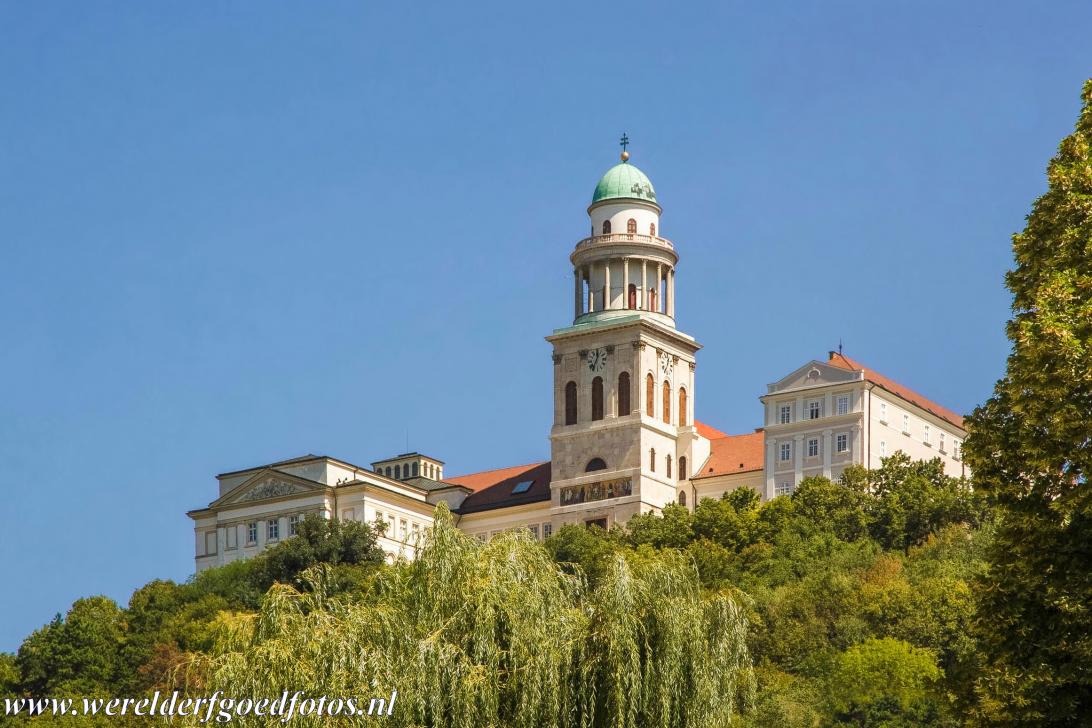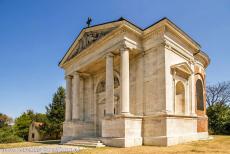Millenary Benedictine Abbey of Pannonhalma and its Natural Environment: The Benedictine Abbey of Pannonhalma was the first Christian monastery of Hungary. The abbey is situated on a nearly 300 metres high rock. The Abbey of Pannonhalma was founded by Grand Prince Géza in 996 and erected in honour of Saint Martin of Tours. The monks of the Abbey of Pannonhalma played an important role in the spread of Christianity into a large part of Central Europe during the Middle Ages and in handing down the classic civilisation. In 1055, the first document in the Hungarian language was written in the Abbey of Pannonhalma. This document is still preserved in the abbey library. The Benedictine monks founded a school in 1802 and education became a central part in the life of the order. Today, there are about 50 monks living in the abbey. In order to celebrate the settlement of the Magyars (Hungarians) in the Pannonian Plain in 896, seven Millennium Monuments were erected in 1896. One of them in Pannonhalma. The name of the Abbey of Pannonhalma is related to the Pannonian Plain. The Millenary Benedictine Abbey of Pannonhalma and its Natural Environment became a UNESCO World Heritage in 1996.
www.werelderfgoedfotos.nl © Copyright World Heritage Photos

The Benedictine Abbey of Pannonhalma is situated on the top of an almost 300 metres high hill, the abbey was founded by Grand Prince Géza of Hungary in 996 and erected in honour of Saint Martin of Tours. The abbey is one of the oldest historical monuments in Hungary. The Abbey of Pannonhalma and its Natural Environment became a UNESCO World Heritage in 1996.

The Benedictine Abbey of Pannonhalma is situated on the top of an almost 300 metres high hill, the abbey was founded by Grand Prince Géza of Hungary in 996 and erected in honour of Saint Martin of Tours. The abbey is one of the oldest historical monuments in Hungary. The Abbey of Pannonhalma and its Natural Environment became a UNESCO World Heritage in 1996.

The Benedictine Abbey of Pannonhalma was the first Christian monastery in Hungary. St. Martin of Tours is the patron saint of the abbey. The Benedictine monks founded a school in 1802 and education became a central part in the life of the Benedictine order. Now, the school still exists. The abbey was visited by the Polish-born Pope John Paul II in 1996 and the Dalai Lama in 2000.

Benedictine Abbey of Pannonhalma: The monks of the abbey played an important role in the spread of Christianity into a large part of Central Europe during the Middle Ages and in handing down the classic civilisation. In 1055, the first document in the Hungarian language was written in the Abbey of Pannonhalma. This priceless document is still preserved in the abbey library.

Benedictine Abbey of Pannonhalma: The arched cloister of the abbey, the Gothic cloister was built in the 15th century. The abbey became an important centre of Christianity and Western culture. Today, there are about fifty monks living in the abbey. The Millenary Benedictine Abbey of Pannonhalma and its Natural Environment was declared a UNESCO World Heritage in 1996.

Millenary Benedictine Abbey of Pannonhalma: The library was built in the neoclassical style in the 19th century. The ceiling of the oval hall is decorated with painted colourful medallions. The impressive library has four storeys and houses 360,000 volumes. The oldest manuscripts in the library date from the 11th century. It is one of the richest monastery libraries in Europe.

Benedictine Abbey of Pannonhalma: The Millennium Monument of Pannonhalma is situated not far from the Abbey of Pannonhalma. The monument was erected in 1896 to commemorate the 1000th anniversary of the settlement of the Magyars (Hungarians) in the Carpathian Basin, also known as the Pannonian Basin. it is one of the seven Millennium Monuments in Hungary.
